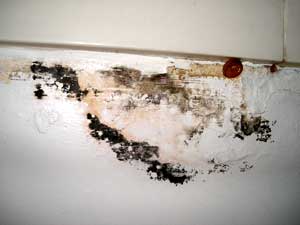
Vol. IV, No. 6, October/November/December 2005
- Designing Child Care Centers for Ease of Cleaning
- Mold: an Overlooked Threat to Children's Health
- Drop-Off and Pick-Up Should Be Safe
- Benefits of Children Playing Outside
- Preschool Outdoor Environment Measurement Scale (POEMS®)
- Fall = Visiting the Farm
- AblePlay™ Helps Evaluate Toys for Children with Special Needs
- Current Projects
- Child Care Design Institute for New Center Owners/Operators
Mold: an Overlooked Threat to Children's Health
 Mold
is part of the fungus family, along with mushrooms and yeast. Mold spores
are very small, and they travel easily through the air. There are many
types of mold, both indoors and outdoors.
Mold
is part of the fungus family, along with mushrooms and yeast. Mold spores
are very small, and they travel easily through the air. There are many
types of mold, both indoors and outdoors.
Mold grows mainly on building materials such as wood, drywall, carpet, wallpaper and foundations walls where there is excess moisture, dampness or water accumulation. Mold is found in basements, bathrooms, and kitchens, in humidifiers, air conditioners, air ducts, air filters, furnaces or drip pans. It can range in color from white to orange and from green to black. Mold often smells musty or earthy. The best way to identify mold is to dab the area with chlorine bleach. If the color disappears or changes, the culprit is probably mold.
Everyone is exposed to mold, but infants and young children are among those most at risk for mold reactions. When mold spores are inhaled they can cause or trigger allergies, asthmas and respiratory symptoms such as a dry cough. Mold exposure can also cause watery eyes, headaches, skin irritation, or headaches.
The most dangerous mold produces toxins. It is usually dark green to black in color and is slimy when wet. It grows slowly in dark and humid areas that have been wet for several days. This type of mold can cause severe health problems when it is disturbed (for example when cleaning). It cannot be killed by bleach and is most dangerous after drying because the spores can travel through the air. If you suspect that you have this type of mold growing in your center, contact your local public health unit for assistance.
The best way to get rid of non-toxic mold is to clean and disinfect, otherwise the mold will come back. If you have experienced flood damage, you should contact a professional for clean up. Only chlorine bleach on contact can kill mold. When cleaning up mold, wear a long sleeve shirt, a mask and plastic gloves along with safety goggles.
The recommended steps for eliminating mold are to first soak the moldy area in chlorine bleach for 15 minutes. Then wash the area with a bleach cleanser made of one part chloride bleach to four parts water and a few drops of non-ammonia dishwashing detergent (do not use ammonia and bleach as it is a dangerous combination). Rinse and then dry quickly. Throw out any moldy items that cannot be cleaned and thoroughly dried.
The best way to prevent mold growth is to control the humidity levels
in your center (30-50%), avoid drying items indoors, avoid using carpets
in classrooms, install good ventilation in attics and basements and be
sure to check and repair all water leaks as soon as possible. Cleaning
the drip pans in your air conditioner, refrigerator and dehumidifier will
also help to control mold growth.
Vol. IV, No. 6, October/November/December 2005
- Designing Child Care Centers for Ease of Cleaning
- Mold: an Overlooked Threat to Children's Health
- Drop-Off and Pick-Up Should Be Safe
- Benefits of Children Playing Outside
- Preschool Outdoor Environment Measurement Scale (POEMS®)
- Fall = Visiting the Farm
- AblePlay™ Helps Evaluate Toys for Children with Special Needs
- Current Projects
- Child Care Design Institute for New Center Owners/Operators

